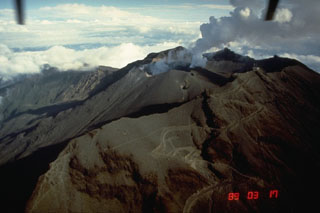Report on Galeras (Colombia) — November 1994
Bulletin of the Global Volcanism Network, vol. 19, no. 11 (November 1994)
Managing Editor: Richard Wunderman.
Galeras (Colombia) Seismicity, deformation, and SO2 flux at low levels
Please cite this report as:
Global Volcanism Program, 1994. Report on Galeras (Colombia) (Wunderman, R., ed.). Bulletin of the Global Volcanism Network, 19:11. Smithsonian Institution. https://doi.org/10.5479/si.GVP.BGVN199411-351080
Galeras
Colombia
1.22°N, 77.37°W; summit elev. 4276 m
All times are local (unless otherwise noted)
. . . Galeras displayed weak seismicity and deformation during November. Both tremor and long-period screw-type events (monochromatic and with a slow coda decay) continued. In addition to these signals, earthquakes took place. Some were located in the volcano's W sector at superficial depths. Others were located on the NW flank 3.5-4 km from the crater at 2-3 km depth. A third group struck on the NE flank in an area activated on previous occasions. Tiltmeters showed no significant change during November.
Tremor on 4 November lasted for 16 minutes (starting at 1638), on 5 November, for 43 minutes (starting at 1942). Coincident with the tremor, increased rain fell and a rise in mud flows was noted on the Azufral river in the W sector.
Airborne observers flying over the main crater noted a migration and an increase in the release of fumarolic gases. The escaping gases had migrated toward the external western wall of the cone and they concentrated along a tangentially oriented crevice and in some key fumaroles of this area. Nevertheless, the monthly SO2 measurements yielded low flux values for November.
Geological Summary. Galeras, a stratovolcano with a large breached caldera located immediately west of the city of Pasto, is one of Colombia's most frequently active volcanoes. The dominantly andesitic complex has been active for more than 1 million years, and two major caldera collapse eruptions took place during the late Pleistocene. Long-term extensive hydrothermal alteration has contributed to large-scale edifice collapse on at least three occasions, producing debris avalanches that swept to the west and left a large open caldera inside which the modern cone has been constructed. Major explosive eruptions since the mid-Holocene have produced widespread tephra deposits and pyroclastic flows that swept all but the southern flanks. A central cone slightly lower than the caldera rim has been the site of numerous small-to-moderate eruptions since the time of the Spanish conquistadors.
Information Contacts: INGEOMINAS, Pasto.

